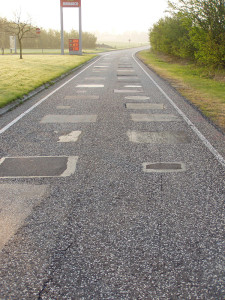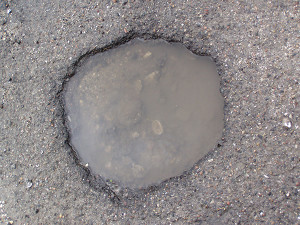The winter 2013/2014 has in Denmark been reasonably mild, but normally it has been high season for a special kind of damage to our roads – Potholes. In places where the pavement conditions are not optimal and the climate during wintertime provides wet conditions and freeze-thaw cycling potholes can be a very eminent problem. It is very much in focus in public media since the occurrence and the repair have impact for road users with respect to traffic safety, reduced speed, traffic congestion etc.
For the road administrations and contractors potholes are a technical challenge of huge proportions. Conclusion: a worthy research topic for a pan-European project like POTHOLE.

Inspection of the repair material trial sectons at Tuelsø one misty morning after five years under traffic. Photo: Erik Nielsen
With cross-border funding from the ERANET Road organization in response to the call in 2011 under the theme Design: Rapid and Durable Maintenance Methods and Techniques a research project POTHOLE was started in October 2011 for duration of two years. The project name is almost self-explanatory, but the full title is “Durable Pothole Repairs”. The broad European interest is also shown in the constitution of the consortium:
- Karlsruhe Institute of Technology (KIT), Germany – project coordinator
- Forum of European Highway Research Laboratories (FEHRL), Belgium
- Transport Research Laboratory (TRL), United Kingdom
- The University of Zilina (UNIZA), Slovakia
- The University of Twente (UT), the Netherlands
- Slovenian National Building and Civil Engineering Institute (ZAG), Slovenia
- Vejdirektoratet (DRD), the national road administration, Denmark
The first objective of the project was to get a proper definition, since many deterioration mechanisms can lead to damage to the pavement but not all result (technically speaking) in potholes. After a huge pan-European questionnaire and information gathering exercise the consortium came up with the following definition:
Pothole: “a local deterioration of the pavement surface in which the material breaks down in a relatively short period of time and is lost causing a steep depression.”
Several notes to the definition highlight characteristics and further details for potholes.
Based on the questionnaires an overview was established and further developed with respect to:
- Test and evaluation methods for laboratory and “in-situ”
- Existing standards, techniques, materials and experience on the European market
- Evaluation of techniques and materials from existing trial sites
Especially Denmark and Slovenia had well established trial sites, but also UK contributed with sites related to their HAPAS schemes for repair material certification. One of the major contributions to the project from Vejdirektoratet was the results from the Tuelsø test site, where numerous materials have been tested since 2006 and 2008 for their performance and durability.
POTHOLE set up a laboratory testing protocol for a large number of materials and associated references which was performed at UNIZA and contributed to the Life Cycle Cost and Benefit Analysis which was conducted by UT. Four different scenarios combined variations in traffic amount, expected evolution of potholes, remaining service life of pavement and durability of pothole repair materials. The analysis gives good insight for road administrations about the impact of parameters on the optimum strategy to handle pothole repair.
It is not possible here to report the findings of the POTHOLE project in this magazine, but all the reports can be downloaded from the POTHOLE File Zone at the FEHRL website.
Text: Erik Nielsen, Jeanne Rosenberg and Jørn Raaberg
 Contact: Contact:Erik Nielsen enie@vd.dk DRD, Denmark |
 Contact: Contact:Jørn Raaberg jra@vd.dk DRD, Denmark |







Follow us: